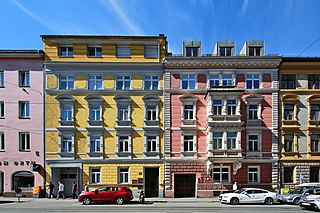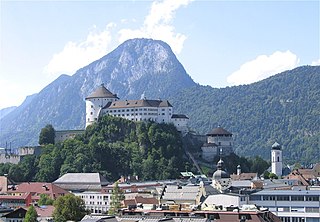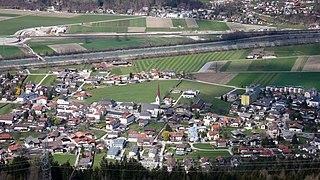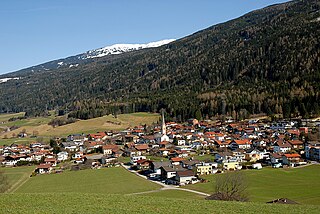
Innsbruck is the capital of Tyrol and the fifth-largest city in Austria. On the River Inn, at its junction with the Wipp Valley, which provides access to the Brenner Pass 30 km (18.6 mi) to the south, it had a population of 132,493 in 2018.

Kufstein (German pronunciation: [ˈkʊfˌʃtaɪ̯n] is a town in the Austrian state of Tyrol, the administrative seat of Kufstein District. With a population of about 18,400, it is the second largest Tyrolean town after the state capital Innsbruck. The greatest landmark is Kufstein Fortress, first mentioned in the 13th century. The town was the place of origin of the Austrian noble family Kuefstein de.

Landeck is a city in the Austrian state of Tyrol, the capital of the district of Landeck.

Swarovski is an Austrian producer of glass based in Wattens, Austria, and has existed as a family-owned business since its founding in 1895 by Daniel Swarovski.

Rattenberg is a City on the Inn River in the Austrian state of Tyrol near Rattenberg mountain and Innsbruck. With just 400 inhabitants and a surface area of 10 ha, it is the smallest city in the country.

Hall in Tyrol is a town in the Innsbruck-Land district of Tyrol, Austria. Located at an altitude of 574 m, about 5 km (3 mi) east of the state's capital Innsbruck in the Inn valley, it has a population of about 13,000.

Absam is a municipality in the Innsbruck-Land District, Tyrol (Austria) situated at an altitude of 632 m, which had an area of 51.92 km2 and 6,776 inhabitants as January 2015.

Baumkirchen is a community in the district of Innsbruck Land. It lies in the Inn Valley north of the Inn River on a batter of the Gnadenwald terrace. The village can be reached via the Inn Valley Motorway.

Flaurling is a municipality in the district Innsbruck country in Tyrol (Austria). It lies in the Inn valley between Innsbruck and Telfs south of the Inn River.

Fritzens is a municipality in the district Innsbruck country in Tyrol (Austria). It lies 16 km east of Innsbruck on the left side of the Inn River. The origin of the village goes back until 6 BC.
Terfens is a municipality in the Schwaz district with 2116 inhabitants in the Austrian state of Tyrol. It is located about 20 km northeast of Innsbruck in the Lower Inn Valley.

Grinzens is a municipality in the Austrian state of Tyrol in the district of Innsbruck-Land. As of January 2015, its population is 1414. It lies southwest of the city of Innsbruck at an elevation of 945 m.
Wattenberg is a municipality in the district of Innsbruck-Land in the Austrian state of Tyrol located 15 km east of Innsbruck and 2.50 km above the Swarovski crystal town Wattens.

Volders is a municipality in the district of Innsbruck-Land in the Austrian state of Tyrol located 12 km east of Innsbruck on the southern side of the Inn River.

Unterperfuss is a municipality in the district of Innsbruck-Land in the Austrian state of Tyrol located 15 km west of Innsbruck and is one of the smallest villages of Tyrol. The area is restricted in the north by the Inn River and in the east by the Melach River. Unterperfuss has many facilities for horse-riding.

Rinn is a municipality in the district of Innsbruck-Land in the Austrian state of Tyrol located 6 km southeast of Innsbruck. The village was mentioned in documents as “Runne” in 1250 for the first time.

Mils is a municipality in the district Innsbruck-Land of Tyrol, Austria. It is located 12 km east of Innsbruck. The area is restricted by the Weißenbach in the west and the Inn in the south. The location was mentioned in documents in 930 for the first time. In the last 40 years Mils grew enormously thanks to its sunny location.

The Tyrol S-Bahn provides regional rail services in metropolitan Innsbruck, Austria and its hinterlands in the state of Tyrol. At present, it is only a nominally an S-Bahn in that it only operates on the lines of the Austrian Federal Railways. Expansion projects, including new stations, however, are being planned.

The Innsbruck bypass is a 14.853 kilometre-long double-track electrified main line of the Austrian railways. It connects the Lower Inn Valley railway with the Brenner railway, bypassing Innsbruck. It was opened on 29 May 1994. The line is at a major part of the rail freight network of Austrian Federal Railways (ÖBB).

Swarovski Kristallwelten is an experience attraction created by André Heller for the crystal glass manufacturer Swarovski, consisting of a park, art museum, retail area, and restaurant. It opened in 1995 and is located in the Austrian Tyrol, in the town of Wattens, Innsbruck-Land District, where the company was founded and still has its headquarters today. Kristallwelten, together with the Swarovski Kristallwelten Store in Innsbruck and Vienna, form D. Swarovski Tourism Services GmbH.























